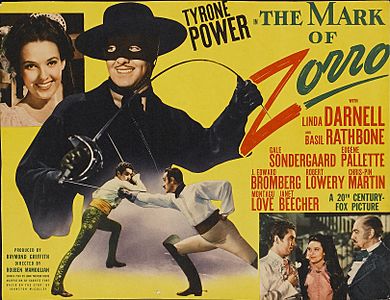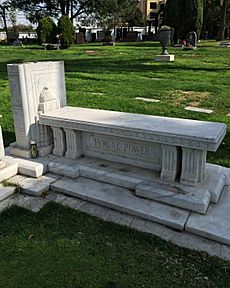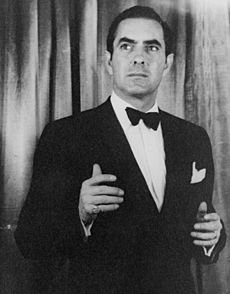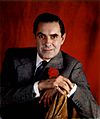Tyrone Power facts for kids
Quick facts for kids
Tyrone Power
|
|
|---|---|
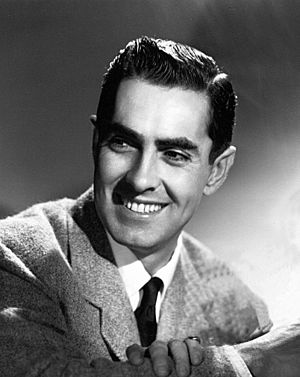
Power in the 1940s
|
|
| Born |
Tyrone Edmund Power III
May 5, 1914 Cincinnati, Ohio, U.S.
|
| Died | November 15, 1958 (aged 44) Madrid, Spain
|
| Burial place | Hollywood Forever Cemetery, Los Angeles, California, U.S. |
| Occupation | Actor |
| Years active | 1932–1958 |
| Spouse(s) |
|
| Children |
|
| Parent(s) |
|
| Military career | |
| Allegiance | |
| Service/ |
|
| Years of service |
|
| Rank |
|
Tyrone Edmund Power III (born May 5, 1914 – died November 15, 1958) was a famous American actor. From the 1930s to the 1950s, Power starred in many movies. He was often known for playing heroes in adventure films, like those with sword fights, or romantic lead characters. Some of his most famous movies include Jesse James, The Mark of Zorro, Marie Antoinette, and Witness for the Prosecution.
Even though he was known for his good looks, Power acted in many different types of films. These included serious dramas and light comedies. In the 1950s, he started making fewer movies. He wanted to spend more time acting in plays on stage. He earned great praise for his stage roles in John Brown's Body and Mister Roberts. Tyrone Power sadly died from a heart attack when he was 44 years old.
Contents
Who was Tyrone Power?
His Family and Early Life
Tyrone Power was born in Cincinnati, Ohio, in 1914. His father, Tyrone Power Sr., was also a well-known stage and screen actor. Tyrone came from a long line of actors from Ireland. His great-grandfather, also named Tyrone Power, was a famous Irish actor.
His sister, Ann Power, was born in 1915 after his family moved to California. Tyrone's mother was Roman Catholic. Her family had French-Canadian and French roots. Through his family, Tyrone was also related to other famous people. These included the actor Laurence Olivier and the author Evelyn Waugh.
Power went to Catholic schools in Cincinnati. He graduated from Purcell High School in 1931. After finishing school, he decided to join his father. He wanted to learn about acting from one of the best actors of his time.
Starting His Acting Career
In the summer of 1931, Tyrone joined his father. They had been apart for several years because his parents had divorced. Sadly, his father had a heart attack in December 1931 and died in Tyrone's arms. This happened while his father was getting ready to perform in a play.
Tyrone Power Jr., as he was called then, decided to keep acting. He tried to find work, but it was hard. Many people knew his father, but they didn't offer Tyrone any jobs. He had a small part in a movie called Tom Brown of Culver in 1932. But this didn't lead to more roles. He also worked as an extra in Flirtation Walk.
Feeling discouraged, he took a friend's advice. He went to New York to get more experience acting on stage. He performed in Broadway plays like Flowers of the Forest, Saint Joan, and Romeo and Juliet.
Becoming a Movie Star
His Rise to Fame in the 1930s

Power moved to Hollywood in 1936. A director named Henry King was very impressed by how he looked and acted. King insisted that Power try out for the main role in Lloyd's of London. This role was expected to go to another actor, Don Ameche.
Even though Darryl F. Zanuck had doubts, he gave Power the role. King and film editor Barbara McLean convinced him that Power was better for the screen. Power was listed fourth in the movie's credits. But he had the most time on screen of anyone in the cast. He went to the movie's premiere as an unknown actor. He left as a star, and he stayed a star for the rest of his career.
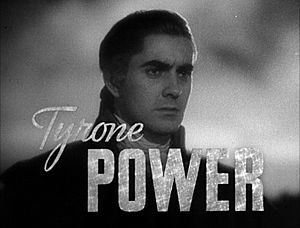
From 1936 until 1943, Power had many hit movies. His career was then paused for military service. During these years, he starred in many types of films. These included romantic comedies like Thin Ice, and dramas like Suez and Blood and Sand. He also appeared in musicals, westerns like Jesse James, and war films.
Jesse James was a huge success at the box office. However, some people criticized it for making the famous outlaw seem too good. This movie was filmed in and around Pineville, Missouri. It was Power's first time filming on location. It was also his first movie filmed in Technicolor. By the end of his career, he had made 16 movies in color.
Power was loaned out once to MGM for Marie Antoinette (1938). He was Fox's biggest star, and he played a supporting role in that film. After this, his studio boss, Darryl F. Zanuck, decided not to loan him out again. In 1939, Power was named the second biggest box-office draw, right after Mickey Rooney. His movies made a lot of money.
Becoming Zorro in the 1940s
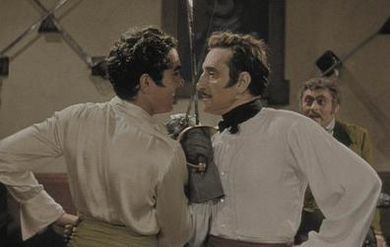
In 1940, Power's career changed direction with the movie The Mark of Zorro. Power played Don Diego Vega, who was a fancy gentleman by day and a bandit hero named Zorro by night. This role had been played by Douglas Fairbanks in a 1920 movie.
The film was a big hit. Because of its success, 20th Century-Fox often cast Power in other adventure films with sword fighting. Power was very skilled with a sword in real life. The sword fight scene in The Mark of Zorro is still highly praised. Basil Rathbone, a famous Hollywood swordsman who acted with Power in the movie, said: "Power was the most agile man with a sword I've ever faced before a camera."
Power's acting career was put on hold in 1943 when he joined the military. He reported for training with the United States Marine Corps in late 1942. But 20th Century-Fox asked him to finish one more movie first. This was Crash Dive, a patriotic war film released in 1943. He was credited in the movie as Tyrone Power, U.S.M.C.R. The movie also helped encourage people to join the military.
Military Service
In August 1942, Power joined the United States Marine Corps. He went through basic training and then Officer's Candidate School. He became a second lieutenant in June 1943. Power had already flown planes for 180 hours before joining. This meant he could do a quick, intense flight training program. He earned his pilot wings and was promoted to first lieutenant.
The Marine Corps thought Power was too old for active combat flying. So, he volunteered to pilot cargo planes. He hoped this would get him into active combat zones. In July 1944, Power was assigned to a Marine Transport Squadron. He worked as a co-pilot for transport planes.
In February 1945, Power joined another squadron in the Marshall Islands. From there, he flew missions during the Battles of Iwo Jima and Okinawa. He carried supplies and brought wounded Marines out of the combat areas.
For his service in the Pacific War, Power received several awards. These included the American Campaign Medal and the Asiatic-Pacific Campaign Medal. He also received the World War II Victory Medal.
Power returned to the United States in November 1945. He was released from active duty in January 1946. He was promoted to captain in the reserves in 1951. He stayed in the reserves for the rest of his life. He reached the rank of major in 1957.
People who served with Power respected him greatly. Jerry Taylor, a retired Marine Corps flight instructor, remembered training Power. He said, "He was an excellent student, never forgot a procedure I showed him or anything I told him." After the war, 20th Century-Fox gave Power a surplus plane. He named it The Geek and often flew it himself. When Power died suddenly at 44, he was buried with full military honors.
After the War: His Later Career
Late 1940s Films
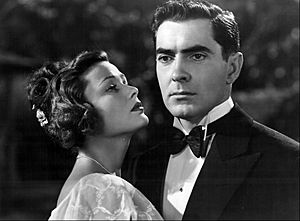
After serving in the Marines, Power did not appear on screen again until 1946. He then starred with Gene Tierney and Anne Baxter in The Razor's Edge. This movie was based on a famous novel by W. Somerset Maugham.
Next, Power fought hard to make a film called Nightmare Alley (1947). His boss, Darryl F. Zanuck, did not want him to make it. Zanuck worried that such a dark role would hurt Power's popular image. Power was known for his handsome looks and charming manner. Zanuck finally agreed, giving the film a high budget.
The movie was directed by Edmund Goulding. It did not do well at the box office. But it was one of Power's favorite roles. He also received some of the best reviews of his career for it. However, Zanuck still disliked seeing his "darling boy" in such a dark film. So, he did not promote it and removed it from theaters quickly. The film was finally released on DVD in 2005.
Zanuck quickly released another costume movie, Captain from Castile (1947). This was directed by Henry King, who directed Power in eleven movies. After making a few light romantic comedies, Power starred in two more adventure films: Prince of Foxes (1949) and The Black Rose (1950).
The 1950s and Stage Work
Power was becoming tired of always playing costume roles. He wanted to be a great actor, not just a star. He had to take roles he didn't like, such as American Guerrilla in the Philippines (1950). In 1950, he went to England to play the main role in the play Mister Roberts. The show sold out for 23 weeks.
Power refused to star in another costume film, Lydia Bailey. His role went to another actor, and Power was suspended by the studio. Power then appeared in Diplomatic Courier (1952). This was a spy drama that received mixed reviews.
Power's movies had always made a lot of money for Fox. To get him to renew his contract, Fox offered him the lead role in The Robe (1953). He turned it down, and Richard Burton took the role instead. In November 1952, Power began a national tour with John Brown's Body. This was a dramatic reading of a poem, featuring Power and two other actors. The tour ended with 65 shows on Broadway.
Fox then allowed Power to find his own roles outside the studio. He still had to make 14 films for them between his other projects. He made The Mississippi Gambler (1953) for another studio. He made a deal to get a percentage of the profits and earned a million dollars from the movie. Power also acted in the play The Dark is Light Enough. He toured the United States and Canada in this role.
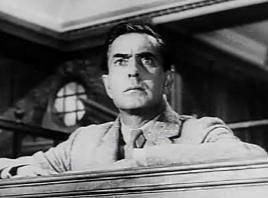
Untamed (1955) was Tyrone Power's last movie under his contract with 20th Century-Fox. That same year, he appeared in The Long Gray Line. In 1956, he returned to England to act in a play called The Devil's Disciple.
Darryl F. Zanuck convinced him to play the lead role in The Sun Also Rises (1957). This was his final film with Fox. Also released that year were Seven Waves Away and Rising of the Moon.
For his last completed film role, Power played the accused murderer Leonard Vole. This was in the first movie version of Agatha Christie's Witness for the Prosecution (1957). The film was a big success and received good reviews. Power returned to the stage in March 1958. He played the lead in a play called Back to Methuselah.
His Personal Life
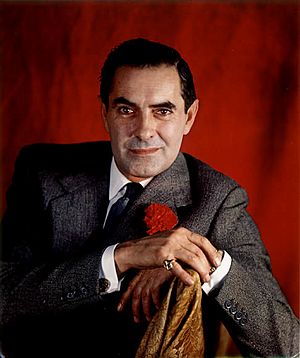
Tyrone Power was one of Hollywood's most sought-after bachelors. He married French actress Annabella on July 14, 1939. They met while working together on the movie Suez. Power adopted Annabella's daughter, Anne.
Their marriage faced challenges. Annabella said that the war in Europe made her unhappy. She started taking stage roles, which often took her away from home. She said, "It is always difficult to put one's finger exactly on the place and time where a marriage starts to break up." They tried to make their marriage work after Power returned from military service, but they divorced in 1948.
After his divorce from Annabella, Power had a relationship with actress Lana Turner.
In 1946, Power and his friend Cesar Romero went on a trip through South America. They met Juan and Evita Peron in Argentina. In 1947, Power went on another trip around the world, flying his own plane, "The Geek". He was a skilled pilot and genuinely liked people.

In 1948, while in Rome, Power met and fell in love with Mexican actress Linda Christian. Power and Christian were married on January 27, 1949. Thousands of fans gathered outside the church. They had two daughters: Romina Francesca Power, born in 1951, and Taryn Stephanie Power, born in 1953. Around the time Taryn was born, their marriage became difficult. They divorced in 1955.
After his divorce from Christian, Power had a long relationship with actress Mai Zetterling. He had met her on a movie set. He said he would never marry again because his previous marriages had cost him a lot of money. However, in 1957, he met Deborah Jean Smith. They married on May 7, 1958. Soon after, she became pregnant with Tyrone Power Jr., the son he had always wanted.
His Death
In September 1958, Power and his wife Deborah traveled to Madrid, Spain. He was filming the movie Solomon and Sheba with Gina Lollobrigida. Power was a heavy smoker and likely had a family history of heart disease. He had filmed about 75% of his scenes when he had a massive heart attack. This happened while he was filming a sword fighting scene with his friend George Sanders.
Power died while being taken to the hospital in Madrid on November 15, 1958. He was 44 years old.
Power was buried at Hollywood Forever Cemetery in a military service on November 21. His friend, director Henry King, flew over the service. King felt that he had introduced Power to flying many years before. Flying became a very important part of Power's life.
Power was buried next to a small lake. His grave has a marble bench with masks of comedy and tragedy. It reads: "Good night, sweet prince." At his grave, Laurence Olivier read the poem "High Flight".
Power's will was filed in December 1958. It had an unusual request for that time. He asked that his eyes be donated to a foundation for corneal transplantation or study. Deborah Power gave birth to their son, Tyrone Power Jr., in January 1959. This was two months after her husband's death. She remarried later that year.
Honors and Legacy
For his work in movies, Tyrone Power received a star on the Hollywood Walk of Fame in 1960. It can be found at 6747 Hollywood Blvd. On the 50th anniversary of his death in 2008, Power was honored. The American Cinematheque held a weekend of films and memories from his co-stars and family.
Power is also shown on the cover of The Beatles' famous album Sgt. Pepper's Lonely Hearts Club Band. In 2018, Tyrone Power was ranked the 21st most popular male film star in history.
Filmography
Stage Appearances
- Low and Behold, Pasadena Playhouse and Hollywood Music Box Theatre, CA (1933)
- Flowers of the Forest, Martin Beck Theatre, NY (1935-1936)
- Romeo and Juliet, Martin Beck Theatre, NY (1935)
- Saint Joan, Martin Beck Theatre, NY (1936)
- Liliom, The Country Playhouse, Westport CT (1941)
- Mister Roberts, London Coliseum, England (1950)
- John Brown's Body, Broadway Century Theatre, NY (1952–1953)
- The Dark is Light Enough (1955)
- A Quiet Place, The Playwrights Co. (1955–1956)
- The Devil's Disciple, Winter Garden Theatre, London, England (1956)
- Back to Methuselah, Ambassador Theatre, NY (1958)
Radio Appearances
| Year | Program | Episode | Co-Star |
|---|---|---|---|
| 1940 | Lux Radio Theatre | "The Rage of Manhattan" | w/ Annabella |
| 1941 | Lux Radio Theatre | "Blood and Sand" | w/ Annabella |
| 1942 | Lux Radio Theatre | "This Above All" | w/ Barbara Stanwyck |
| 1949 | Lux Radio Theatre | "The Bishop's Wife" | w/ David Niven |
| 1952 | Lux Radio Theatre | "I'll Never Forget You" | w/ Debra Paget |
| 1954 | Lux Radio Theatre | "The Mississippi Gambler" | w/ Linda Christian |
| 1954 | Suspense | "The Guilty Always Run" | w/ Cathy Lewis |
Images for kids
See also
 In Spanish: Tyrone Power para niños
In Spanish: Tyrone Power para niños


